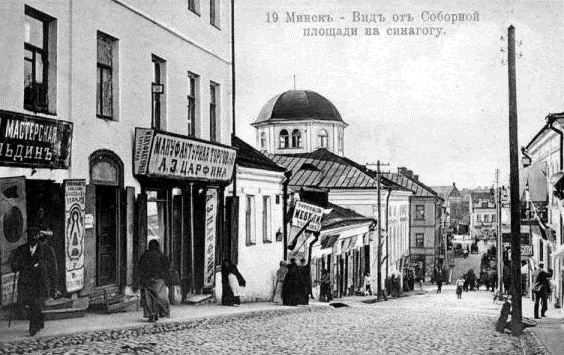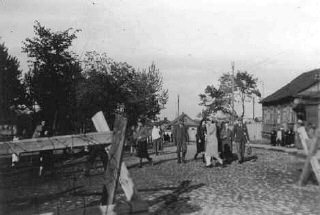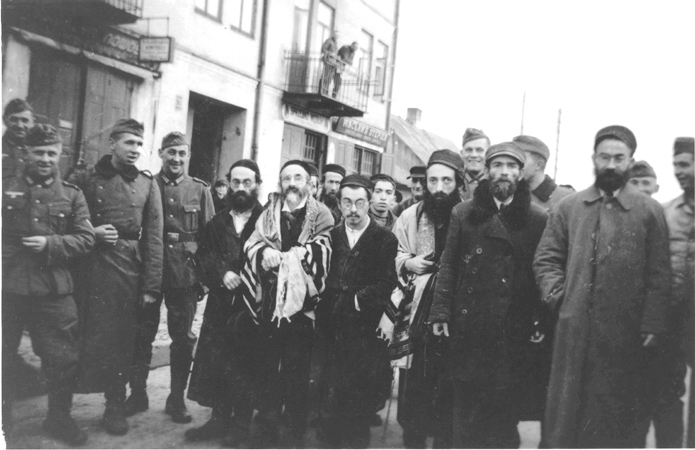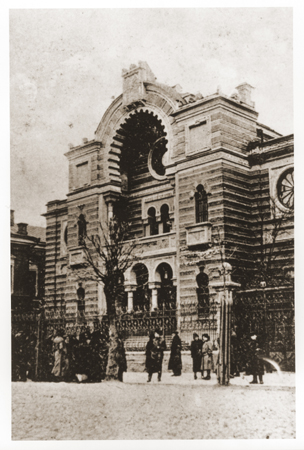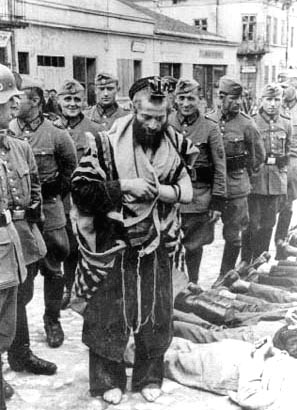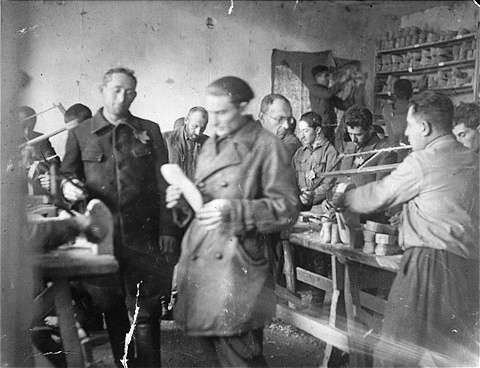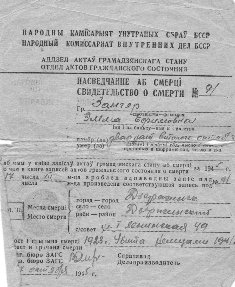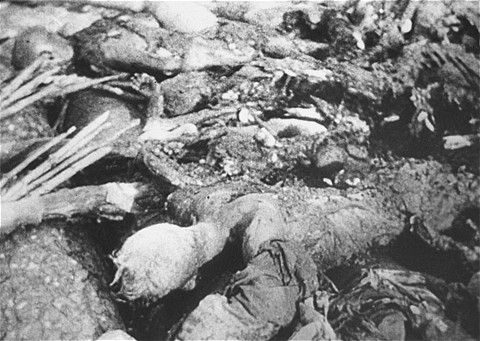Holocaust Education & Archive Research Team |
Ghettos
Minsk Introduction to the Ghettos of the Holocaust
Jewish Ghettos The Judenrat Judenrat Leaders Prominent Jews
| |||||||
The Minsk Ghetto
Minsk, capital of the Belorussian SSR, in 1926 the Jewish population of Minsk was 53,686, by June 1941 the number had grown to 80,000, constituting one- third of the city’s population.
Only a small fraction of the Jews managed to escape from the city in the six days between the German invasion of the Soviet Union and the conquest of Minsk on 28 June 1941.
German parachutists who had been dropped east of the city intercepted thousands of Jews who were trying to flee and forced them to return. When the civil administration was set up Minsk became the headquarters of the Generalkommissar for Belorussian Wilhelm Kube.
Kube was murdered on 22 September 1943 was killed by a bomb planted under his bed, by his maid, a Soviet partisan.
On 8 July 1941, the Germans killed 100 Jews and thereafter the murder of Jews by the Germans singly or in groups, became a daily event. On 20 July 1941, an order was issued on the establishment of the ghetto.
Its area comprised thirty-four streets and alleys, as well as the Jewish cemetery, some of the streets included:
Some of the lanes included:
The ghetto was surrounded by thick rows of barbed wire, watchtowers were erected and round the clock surveillance was established. A living space of 1.5 square meters was allotted for each person, with no space allotted for children. Thousands of the ghetto inhabitants lived among the ruins of destroyed or gutted houses without floors or windows. A curfew was in force from 2200 to 0500 hours.
Jews from Slutsk, Dzerzhinsk, Cherven, Uzda and other nearby places were brought into the ghetto. Married couples with one non-Jewish partner were also put into the ghetto as were their children. Altogether, 100,000 persons were rounded up and put behind the ghetto walls.
In August 1941 5,000 Jews were seized and murdered, the surviving Jews were forced to pay a ransom, to report every Sunday for roll call, and to wear a yellow badge on their back and chest, as well as white patch on their chest with their house number.
News of the killings in Minsk and other places in the East was sent to the chief of the Gestapo in Berlin, Heinrich Muller, who asked Adolf Eichmann to see him, Eichmann being the SS officer in charge of the department IV-D-4, responsible for deportations and emigrations.
Twenty years later, in a court in Jerusalem, on trial for his life, Eichmann recalled that Muller had said to him; “In Minsk they’re shooting Jews. I want you to report how it’s going.”
Eichmann left at once, first to Bialystok and then to Minsk. At his trial he recalled how, reaching the execution site in Minsk he found that:
“There were the piles of dead people. They were shooting into the pit – it was a rather large one, so I was told, perhaps four to five times the size of this room, perhaps even six or seven times. I didn’t think much about it because I could hardly express any thoughts about it – I only saw it and that was quite enough – they were shooting into the pit and I saw a woman, her arms seemed to be at the back, and then my knees went weak and I went away.”
In July 1941 a Jewish Council (Judenrat) was established with Eliyahu Myshkin. He was the former vice-director of the Ministry of Commercial Trade. The Judenrat had seven departments:
The first duty of the Minsk Judenrat was to register the entire Jewish population – this was completed by 15 July 1941. All the men in the ghetto were registered for labour duties and a labour camp was established on Shirokaya Street, where Soviet Prisoners of War accused of offences as well as Jews were sent.
This camp also came to be used as a transit camp for those destined for liquidation. Amongst a number of outrages on 21 July a group of 45 Jews were roped together and ordered to be buried alive by 30 Russian prisoners. The Russians refused to carry out this work and all 75 captives were shot.
On 15 August 1941 Heinrich Himmler visited Minsk and witnessed the shooting of 100 Jews by Artur Nebe’s Einsatzkommando, and this experience caused Himmler to change the methods of mass extermination of the Jewish race in Europe.
Myshkin cooperated with the underground, and in February 1942 he was arrested and hanged. His successor Moshe Yaffe, kept up the Judenrat’s cooperation with the underground, but two Jewish collaborators Epstein and Rosenblatt, managed to infiltrate the Judenrat and to work for the German’s within it.
On 7 November 1941, the Germans conducted an Aktion in several of the ghetto’s streets, rounding up twelve thousand Jews and murdering them in nearby Tuchinka. The houses that the murdered Jews had lived in were now filled with Jews from Germany (called the Hamburg Jews, because that was where the first group came from), who were brought to Minsk in the wake of the 7 November Aktion.
The heads of several of the Jewish Council departments in Minsk – Rudicer of the economic section, Dulski of the housing section, Goldin of the workshop section, and Serebianski, the police commander – had all cooperated with resistance groups, providing clothing, shoes, hiding places and false documents. Serebianski went so far as to hire members of the resistance into the ghetto police.
Also active in helping the resistance in Minsk were two of the secretaries in the labour department, Mira Strogin and Sara Levin. The massacre at Minsk on 7 November was followed within three days by the arrival in the city of the first German Jews, one thousand who had been deported from Hamburg.
“They felt themselves as pioneers who were brought to settle the East,” one eye-witness later recalled.
The deportees from Hamburg were followed within days by more than six thousand deportees from Frankfurt, Bremen, and the Rhineland. On 18 November a train arrived from Berlin. The twenty-two year old Haim Berendt was among the deportees from Berlin.
On reaching Minsk, he later recalled: “the carriages were opened and they started beating us up, driving us out of the carriages in a hurry and, within a moment, there were complete chaos. He who succeeded in getting out of the door was beaten up, women children and men.”
The Berlin deportees were taken beyond the Jewish ghetto of Minsk to a special ghetto for the Jews of Germany known as “Ghetto Hamburg.” There, they became a part of the Jewish labour force in Minsk.
A second Aktion took place on 20 November in which the Germans murdered another seven thousand Jews also in Tuchinka. After the two Aktionen the ghetto underground intensified its activities making preparations for escapes to the forests and widening its network of hiding places in the city.
On the night of 21 December 1941 the bodies of several thousand Soviet prisoners of war were laid out by the Germans along a six kilometre stretch of road in Minsk. On the previous day most of the Russians had been deliberately frozen to death in a march across open fields. Some had been shot when in desperation they had sought some shelter from the fierce wind.
At the beginning of 1942, Karl Gebl and Erich Gnewuch delivered two gas vans to Minsk. Eventually there were to be four such vehicles operating in the Minsk area. Murder of the Jews in the gas vans commenced.
Dr August Becker who was a T4 gassing expert working for the RSHA described a trip to the Eastern Territories in connection with the use of gas –vans to exterminate the Jews;
“In Riga I learned from Standartenfuhrer Potzelt, Deputy Commander of the Security Police and SD in Riga, that the Einsatzkommando operating in Minsk needed some additional gas-vans as it could not manage with the three existing vans it had.
At the same time I also learned from Potzelt that there was a Jewish extermination camp in Minsk. I flew to Minsk by helicopter, correction, in a Fiesler Storch belonging to the Einsatzgruppe.
Travelling with me was Hauptsturmfuhrer Ruhl, the head of the extermination camp at Minsk, with whom I had discussed business in Riga . During the journey Ruhl proposed to me that I provide additional vans since they could not keep up with the exterminations. As I was not responsible for the ordering of gas-vans, I suggested Ruhl approach Rauf’s office.
When I saw what was going on in Minsk – that people of both sexes were being exterminated in their masses, that was it – I could not take any more and three days later, it must have been September 1942, I travelled back by lorry via Warsaw to Berlin.”
On the eve of Purim 1942, the German’s ordered the Jewish Council to hand over five thousand Jews for deportation “to the west.” The Council did not know what to do. Some members suggested that small children, and the elderly, might be sent away.
But some Jews who wanted no collaboration, whatsoever with the Germans, in these demands insisted on “no trading in Jewish souls.” Hiding places had already been prepared in cellars and ruined buildings – those who felt they were in danger hid.
On the morning of 2 March the Jewish labour battalions were sent out of the ghetto as usual. Then the Gestapo approached the Jewish Council for the five thousand, urging haste, “because the trains were ready and waiting.”
The Jewish Council refused, in retaliation the Gestapo sent German and White Russian policemen to search the ghetto. Reaching a children’s nursery, they ordered the woman in charge, Dr Chernis, and the supervisor, Fleysher, to take their children to the Jewish Council building.
The order was a trap. On reaching a specially dug pit on Ratomskaya Street, the children were seized by Germans and Ukrainians and thrown alive into the deep sand. At that moment, several SS officers, among them Wilhelm Kube, arrived, whereupon Kube, immaculate in his uniform, threw handfuls of sweets to the shrieking children. All the children perished in the sand.
When the Germans asked for the leader of the underground, Hersh Smolar to be surrendered to them, the Judenrat chairman produced Smolar’s bloodstained identity card as proof that he was dead. That night, when the Jewish forced labourers returned to Minsk from their forced labours outside the ghetto, they were ordered to lie down in the snow outside the ghetto gates. Any who tried to get up and run into the ghetto were shot.
Others were taken to the pit in Ratomskaya Street and killed. Some were marched away from the city, to the Kodianovo forest and murdered there. At least five thousand Jews were killed in Minsk during that Purim day.
The Germans also institued Aktionen at nights resorting to them with increasing frequency, in the spring of 1942, in one such night Aktion on 2 April, about five hundred persons were murdered.
On 7-8 May 1942 the Germans opened a camp at Maly Trostinec, east of Minsk, three miles from the village of Maly Trostinec in the Blagovshchina forest, solely for the purpose of extermination.
On 2 June 1942 there was a deportation of Jews from Vienna. They were taken by train to Minsk and there, in the Minsk ghetto, shared the fate of tens of thousands of deportees to Minsk : starvation, sadistic cruelties, and mass executions.
Among those deported on 2 June was a milliner, Elsa Speigel. It was three weeks before her thirty-third birthday. She was never heard of again. But in Vienna she left her tiny son, Jona Jakob Speigel, a baby of of five and a half months. Elsa Speigel’s decision to leave her baby in Vienna saved his life. He was deported from Vienna to Theresienstadt, but by a miracle he was still alive when the Soviets liberated the transit camp.
Between 28 and 31 July 1942 the Germans killed some thirty thousand Jews, among them the German Jews who were in a separate ghetto in Minsk. The Germans forced Jaffe to speak to the Jews in terms designed to allay their fears, but when trucks with gas engines burst upon the square where they had assembled, Yaffe cried out, “Jews the bloody murderers have deceived you – flee for your lives!”
Yaffe and the ghetto police chief were among the victims of that Aktion, following which only nine thousand Jews were left in Minsk. The collaborators took the place of the Judenrat which ceased to exist.
On the 4 August 1942 a train with a thousand Jews left Theresienstadt, six days later it reached Maly Trostinec, where it stopped in open country. Forty “experts” had already been taken off the train at Minsk. The remaining 960 deportees were ordered out of the carriages and into vans for the next stage of their journey, and driven off towards the forest.
The vans were gas vans, once they reached the forest the doors were unlocked and bodies of the gassed Jews were thrown into open graves. Of a thousand Jews sent from Theresienstadt to Maly Trostinec in a further deportation on 25 August, only twenty-two of the younger men were taken to work at an SS farm. The rest were ordered into the gas vans and killed.
Of the twenty-two men sent to the SS farm, two survived the hard labour and sadism of their overseers, and escaped in May 1943 to join the partisans. One was killed in action, the other survived the war. By the 1 August 1942 there were officially 8794 people still alive in the ghetto. The SS, Police and Gestapo officials who were responsible for numerous atrocities, were Richter, Hettenbach, Fichtel, Menschel, Wentske and others.
Early in February 1943, two previously unknown Germans appeared in the ghetto, Adolf Ruebe and his assistant Michelson. Over the ensuring months Rube and Michelson, the new Police Chief Bunge and his deputy Scherner, terrorised the ghetto. Shootings became so commonplace that people were afraid to venture onto the streets. Orphaned children, the elderly and the disabled were systematically exterminated.
In May 1943 with most of the Jewish doctors murdered, patients were shot in their hospital beds. A well known local doctor Niuta Jurezkaya, had escaped from the ghetto to the forest. But she was caught brought back to Minsk and tortured. “Who was with you?” she was asked. “All of my people were with me,” she replied, and was then shot,
Between four days from the18 to 22 September 1943 transports of Minsk Jews left for the Sobibor death camp and also in the same month on the 10th two thousand Jews were sent to the Budzyn Labour Camp near Lublin.
On October 21 a week after the Sobibor death camp revolt masterminded by Jewish soldiers deported from Minsk, all two thousand Jews in Maly Trostinec, the last survivors from the Minsk ghetto were rounded up and killed in pits outside the city.
On the day of this massacre, twenty-six Jews Jews hid in an underground bunker which had been built by two Jewish stonemasons. In the first month three died, the survivors buried them in the ground on which they themselves lay.
Two girls left the hide-out in search of food, they were captured and killed. After eight months, only thirteen of the twenty-six remained alive. There was no more food – the children were in a coma and the adults were weak from hunger.
It was then that a girl called Musya left the hide-out in search of food, she did not look like a Jewess, but she took the risk, nevertheless, of running into someone she knew, and might denounce her to the Germans.
During her search for help, Musya met Anna Dvac, a White Russian woman with whom she had worked in the same factory before the German invasion. Her friend took her home, gave her food and shelter, and then sent her back with food for the other Jews in hiding.
From that day until the arrival of the Red Army six months later, Anna Dvach ensured the survival of the thirteen Jews. When Minsk was liberated on 3 July 1944, only a few Jews of those who had gone into hiding during the final Aktion remained alive.
Encyclopedia of The Holocaust – published by Macmillan Publishing Company New York 1990. The Holocaust – by Sir Martin Gilbert, published by Collins London 1986 Holocaust Historical Society Those Were The Days, by Ernst Klee, Willi Dressen and Volker Riess, published by Hamish Hamilton London 1991 Wiener Library USHMM
Copyright: Robert Raglund H.E.A.R.T 2007
|
